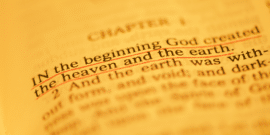Were the Days of Creation 24 Hours Long? Geocentrism: Lessons from a Hard Goodbye

The timing of creation is not the first heated debate the church has worked through on a science-related topic. For three hundred years, the church wrestled over the location of the earth within our solar system. Although emerging scientific findings indicated the sun was at the center of our solar system and the earth rotated around it (heliocentrism), many fervently argued from the Bible that such findings were wrong. They thought the Bible explicitly taught the earth was at the center of the universe, immovable, with everything else rotating around it (geocentrism). They pointed to passages like these:
“[God] set the earth on its foundations, so that it should never be moved”
(Psalm 104:5 – also stated in 1 Chronicles 16:30; Psalm 93:1; 96:10).[1]
“He . . . hangs the earth on nothing” (Job 26:7).
“The sun rises, and the sun goes down, and hastens to the place where it rises” (Ecclesiastes 1:5).
“He has set a tent for the sun, which comes out like a bridegroom leaving his chamber, and, like a strong man, runs its course with joy. Its rising is from the end of the heavens, and its circuit to the end of them” (Psalm 19:4-6).
When Copernicus and then Galileo released scientific findings that challenged the church’s geocentric reading of these passages, they were condemned as “heretical,” “deranged,” and “possessed by the devil.”
For example, the Roman Catholic Church declared in their 1616 Roman Inquisition:
“All have said the stated proposition to be foolish and absurd in Philosophy [i.e., science]; and formally heretical, since it expressly contradicts the sense of sacred scripture in many places, according to the quality of the words, and according to the common exposition, and understanding, of the Holy Fathers and the learned Theologians.”[2]
It was not until 1757 that the Roman Catholic Church began to relax their ban against heliocentric books.[3] Copernicus’ works (published in 1514 and 1543) remained banned until 1822, and it was not until 1835 that the Roman Catholic Church fully lifted its ban on all heliocentric material.[4]
Such a strong objection wasn’t only made by the Catholic Church. Consider the words of key Protestant Reformers such as John Calvin and Martin Luther (two men I highly respect):
“[The Christian is not to compromise so as to obscure the distinction between good and evil, and is to avoid the errors of] those dreamers who have a spirit of bitterness and contradiction, who reprove everything and pervert the order of nature. We will see some who are so deranged, not only in religion but who in all things reveal their monstrous nature, that they will say that the sun does not move, and that it is the earth which shifts and turns. When we see such minds we must indeed confess that the devil possesses them.”
- John Calvin in one of his written sermons[5]
“Even in these things that are thrown into disorder [by heliocentrism] I believe the Holy Scriptures, for Joshua commanded the sun to stand still, and not the earth [Joshua 10:12].”
- Martin Luther during a Table Talk on June 4, 1539 [6]
These are strong words and rather shocking given that hardly any Christians today still hold to a geocentric worldview.
I mention this example from the past because I think we have much to glean from it regarding the current debate on the age of the universe. Let me draw out four general lessons that need to frame our discussions going forward.
We need to discern what the Bible is and is not asserting through the details it mentions.
This past debate provides a helpful insight on our interpretive task. It illustrates our need to distinguish between what the Bible is and is not actually affirming through the things it mentions. It is not enough to comprehend isolated statements in the Bible; one has to follow how the authors are using these statements to communicate their intended message.
It is easy to see why the church initially found the passages above contrary to heliocentrism “according to the quality of the words, and according to the common exposition.” In today’s words, the scientific findings went against the “average person’s plain, straightforward reading of the text.” However, as time went on, the church realized that it had failed to follow how the authors were using these statements to discern what the text was actually asserting.
One of these uses pertained to celestial phenomena merely being referenced from an earthly point of view (like we continue to do today with words like “sunrise” or “sunset”). In noticing this, they realized that these passages were not actually making an assertion about how the universe is composed.
Inerrancy pertains to what the Bible is actually asserting.
While the doctrine of inerrancy is not limited to “faith and practice” (it extends to science and all other domains), it is limited to what the author is actually claiming in the text.
As B. B. Warfield and A. A. Hodge, considered the 19th century bulwarks for inerrancy, put it: “[Inerrancy does not include] an exhaustive rendering of details, an absolute literalness, which the Scriptures never profess” (they call this “exactness of statement”) Rather, it pertains to the “statement of facts or principles intended to be affirmed” (what they label “accuracy”).[7] They write, “Every statement accurately corresponds to truth just as far forth as affirmed.”[8]
They clarify that it is not enough to merely look at what is said in isolated statements (like “He… hangs the earth on nothing,” “it [the earth] should never be moved”). One has to consider how these statements are being used in the discourse as whole. It is only here that we discover what the author is actually claiming. As Warfield and Hodge clarify, “No objection [to inerrancy] is valid which overlooks the prime question: what was the professed or implied purpose of the writer in making this statement?”[9]
The Chicago Statement on Biblical Inerrancy affirms this as well: “We deny that it is proper to evaluate Scripture according to standards of truth and error that are alien to its usage or purpose” (Article XIII).[10]
Discovering a statement’s purpose and discerning what the text is actually asserting along with the precision to which it is asserting it is a matter of hermeneutics (principles for interpreting a text). It involves considerations such as genre, literary form, historical context, etc. This is how we know which details to stand on as reliable, accurate, and without error and which are not meant to be pressed by an “exactness of statement” approach. Inerrancy requires nuancing because truth is asserted in varying ways and to varying degrees in nuanced ways. This is simply the nature of communication.[11]
Science may illumine a misinterpretation of Scripture.
The geocentric debate illustrates how science can, at times, correct our misreading of the text. This is never a matter of dismissing Scripture altogether because of science; rather, it is about allowing scientific data to drive us back to text to see if we may have misinterpreted it.
This is what happened as the evidence mounted for heliocentrism. The church was forced to reconsider their interpretation. Did the Bible actually affirm a geocentric universe, or was it intending to do something else with these statements (like merely reference phenomena from an earthly viewpoint)? As the church went back to the text, they realized they had falsely assumed the text was asserting something it was not.
The Official Commentary on the Chicago Statement on Biblical Inerrancy specifically mentions the church’s false geocentric interpretation to expound on this relationship between science and Scripture:
“We remember with embarrassment that Galileo was condemned as a heretic for asserting heliocentricity against what the church believed to be the teaching of Scripture. However, the scientific discoveries made it necessary for the church to re-examine the teaching on Scripture to see whether or not Scripture actually taught geocentricity or if this was an inference read into the Scripture on the basis of an earlier world view. Upon re-examining what Scripture really taught, the church came to the conclusion that there was no real conflict with science on this question of geocentricity because the Bible did not in fact in any place explicitly teach or assert that the earth was the center of either the solar system or the universe. Here the advances of science helped the church to correct an earlier misinterpretation of Scripture.”[12]
Although my primary motivation in this series is simply to understand Genesis 1-2 on its own terms, there is a rightful place for discussion between disciplines as we seek to make sense of God’s general revelation (through science) and God’s special revelation (through hermeneutics). After all, these two forms of revelation coincide; it is only our interpretations of them that might not. Since it is possible for us to err with both science and hermeneutics (our interpretation, not the text itself!), the discussion needs to go both ways as we sit under and seek to faithfully follow God’s Word.
Our fallibility as interpreters means we need to read Scripture carefully, humbly, and with an openness to correction.
The church’s strong and mistaken condemnation of heliocentrism reminds us that though the Bible is inerrant, we as interpreters are not. This should give us pause when handling difficult and debated texts.[13]
It reminds us of our need for what Kevin Vanhoozer calls “interpretive virtues.” These are attributes such as honesty in acknowledging our prior interests and predispositions, openness to consider other interpretations and to the possibility of changing our understanding, attention to the text (something that requires other virtues like patience, thoroughness, and care), and obedience in following the direction of the text rather than our own desires.[14] We as readers pursue these virtues out of a desire to honor what God has said and to faithfully represent Him to the world.
Overall, we have much to learn from the church’s past rejection of heliocentric evidence due to a poor handling of Scripture. While the details involved in the age of the universe are different than heliocentrism, the example, nevertheless, brings to the forefront hard-learned lessons that should frame our discussions over science and Scripture going forward.
Appendix: The Need for Nuancing
I though it may be helpful to give two other examples on why inerrancy needs to be nuanced and why the “exactness of statement” approach (interpreting statements in isolation at face value) fails to account for how communication works and the various literary devices we find in Scripture.
Example A
Consider the Bible’s use of satire and irony (saying one thing while meaning another). For example, Paul writes to the Corinthian church, “Already you have become rich! You have begun to reign—and that without us! How I wish that you really had begun to reign so that we also might reign with you!”
As we process this statement within its larger context, we realize that Paul is actually trying to discourage their pursuit of honor and wealth. He does not want to reign with them in honor; rather, he is urging them, “imitate me” and “my way of life in Christ Jesus” by becoming “fools for Christ . . .the scum of the earth, the garbage of the world” (1 Corinthians 4:8-17).
Here is an obvious example of our need to consider how individual statements are functioning within the larger discourse. This requires taking note of the literary devices the author may be using. To ignore these devices and insist on an exactness of statement would skew what this text teaches. Assertions are made, and thus need to be discerned, in context. “Literary forms and devices” must be considered because they shape what individual statements are actually asserting (as mention in the Chicago Statement on Biblical Inerrancy, Article XVIII).
Example B
Consider Jesus words: “[The kingdom of God] is like a mustard seed, which is the smallest of all seeds on earth” (Mark 4:31).
Although the mustard seed was generally considered the smallest seed among Jesus’ audience, we now know of several other seeds that are smaller than it (the smallest coming from the orchid family).
Under an “exactness of statement” approach, either Jesus’ claim was false, or an elaborate theory is needed to justify it. I have read some who go so far as to claim these other species with smaller seeds did not yet exist, or had larger seeds in Jesus’ day (although we have no knowledge of this), in attempts to prove the mustard seed was truly the smallest on earth when Jesus made the statement. Thus, Jesus and the Bible did not err in stating this.
This defense would also have to account for Jesus’ following claim that it “grows into the largest of all the garden plants [referencing herbs (cf. Luke 11:42) and vegetables (cf. Romans 14:2) – its etymology (though not always reflective of a words actual meaning) signifies “dug” or cultivated plants as opposed to wild]” (Mark 4:32). This would require another set of species to undergo extensive adaptation subsequent to Jesus’ statement. The whole thing gets complicated.
However, I don’t think this elaborate path is necessary. It is better to simply follow what Jesus is doing with these statements. He is using the mustard seed as a proverbial analogy (as do other Jewish writings) to depict something exceptionally small that grows exceptionally large. Jesus was not using this example to assert a botanical fact; He was merely drawing an analogy from His audience’s cultural sayings (the source domain), to assert something about the kingdom of God (the target domain). His claim is that although the kingdom will start as the smallest, it will grow to be the largest.
This is why the Chicago Statement on Biblical Inerrancy clarifies: “We deny that it is proper to evaluate Scripture according to standards of truth and error that are alien to its usage or purpose” (Article XIII). Focusing on critiquing or defending this passage’s botanical precision misses Jesus’ overall purpose and use of this proverbial statement. It imposes a level of precision beyond what the text (and Jesus) is attempting to make.
Although, more examples can be noted where an “exactness of statement” approach does not work, hopefully these give an indication of its deficiencies. This is why the Chicago Statement on Biblical Inerrancy (to reference a prominent example) does not succinctly define inerrancy, but rather outlines 19 articles of affirmation and denial followed by another 25 articles on biblical hermeneutics. Communication is nuanced and we need to follow these nuances if we are to be faithful with God’s Word.
Go Deeper
- Relying on The Constant Companionship of The Holy Spirit – Package Offer
- God’s Comfort During COVID-19
- Where is God When Life Hurts? – Package Offer
[1] This list of Scripture quotations is from the ESV.
[2] Christopher M. Graney, Setting Aside All Authority: Giovanni Battista Riccioli and the Science against Copernicus in the Age of Galileo (Notre Dame, IN: University of Notre Dame Press, 2015), p. 63.
[3] The tipping point finally came from Isaac Newton’s famous work, Principia. It offered a vast explanatory scope that could only be made sense of in a heliocentric universe. After being published in 1742, the ban was lifted 15 years later.
[4] It is reported that many Christians accepted the heliocentric model rather early even though it was not officially accepted by the Roman Catholic Church for over 300 years. Although the Protestant church was the first to speak against it, they were also the first to accept it once more evidence became available. In fact, members of the Wittenberg Lutheran School are found actively supporting Copernicus’s research before the end of the sixteenth century.
[5] John Calvin, “Sermon on 1 Corinthians 10:19-24”, Calvini Opera Selecta, Corpus Refomatorum, Vol 49, 677, trans. by Robert White in “Calvin and Copernicus: The Problem Reconsidered”, Calvin Theological Journal 15 (1980), pages 236-237.
[6] Martin Luther, Luther’s Works, Vol 54. Table Talk, ed. Helmut T. Lehmann (Philadelphia: Fortress Press, 1967), 358–9.
[7] Here is their larger statement: “There is a vast difference between exactness of statement, which includes an exhaustive rendering of details, an absolute literalness, which the Scriptures never profess, and accuracy, on the other hand, which secures a correct statement of facts or principles intended to be affirmed…It is this accuracy, and this alone, as distinct from exactness, which the church doctrine maintains of every affirmation in the original text of Scripture without exception.” From A. A. Hodge and Β. B. Warfield, Inspiration (Grand Rapids: Baker, 1979, orig. 1881), pp. 28-29.
David Dockery, former president of Trinity Evangelical Divinity School as well as Evangelical Theological Society, gives (in my opinion) the best succinct definition of inerrancy:
“When all the facts are known, the Bible (in its autographs) properly interpreted in light of which culture and communication means had developed by the time of its composition will be shown to be completely true (and therefore not false) in all that it affirms, to the degree of precision intended by the author, in all matters relating to God and his creation.”
https://sbts-wordpress-uploads.s3.amazonaws.com/equip/uploads/2010/01/04sbjt_091_spr05-dockery.pdf, p. 49.
I also highly recommend Kevin Vanhoozer’s articulation of “well-versed inerrancy.” Here is one of his articles on this topic: https://henrycenter.tiu.edu/wp-content/uploads/2013/12/2013April_Vanhoozer-inerrancy.pdf
[8] Hodge and Warfield, Inspiration, p. 29 (italics from original text).
[9] Ibid., pp. 42-43.
[10] https://www.etsjets.org/files/documents/Chicago_Statement.pdf, p. 5.
[11] I will give two further examples of this in the appendix.
[12] R.C. Sproul, http://www.isca-apologetics.org/sites/default/files/Explaining%20Biblical%20Inerrancy.pdf, pp. 45-46.
[13] I appreciate Augustine’s words of wisdom: “To say the right thing is to say what is true and appropriate, not arbitrarily rejecting anything or thoughtlessly affirming anything so long as it is doubtful where the truth lies in the light of the faith and Christian doctrine, but unhesitatingly asserting what can be taught on the basis of the obvious facts of the case or the certain authority of Scripture.” – On Genesis Literally Interpreted, Book 7, Chapter 1, Point 1.
[14] Kevin J. Vanhoozer, Is There a Meaning in This Text? (Grand Rapids, MI: Zondervan Academic, 1998), pp. 376-78. You can read this section at https://www.saintpj.com/p/kevin-vanhoozer-on-4-interpretive-virtues .








